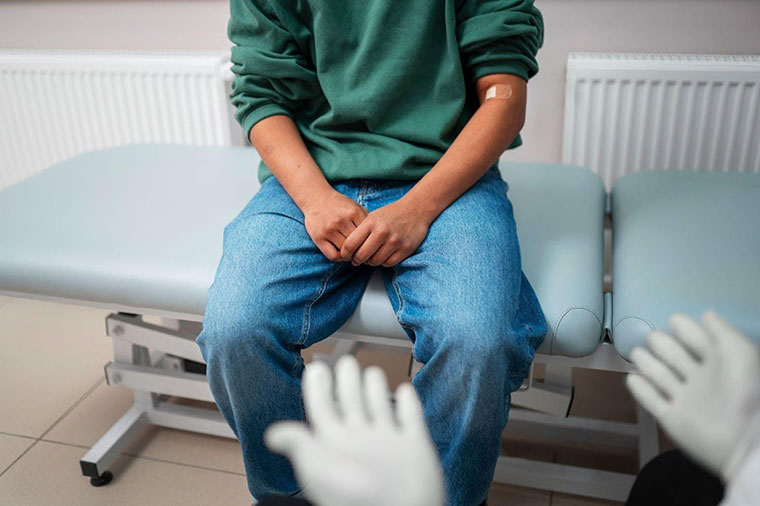Penile Pressure Ulcers Secondary to Condom and Indwelling Catheters and Prone Positioning

Penile pressure ulcers are painful sores that develop on the penis due to prolonged pressure on the skin and underlying tissues. These ulcers can occur when there is continuous pressure without relief, leading to poor blood circulation and tissue damage. Male patients with spinal cord disorders (SCD) are at a higher risk because they may have limited mobility, leading to unrelieved pressure on sensitive areas.
Introduction
The use of condom and indwelling urethral catheters, commonly used for urine drainage, is another significant risk factor. These catheters can cause meatal pressure injuries, which are ulcers at the tip of the penis. Studies show that 22.4% of hospitalized men with condom or indwelling catheters experience these injuries, with some occurring as early as the first day of catheter use. Prone positioning, where patients lie face down, can also increase pressure on the penile area, raising the risk of pressure ulcers.
This article aims to inform male patients about the causes, prevention, and treatment options for penile pressure ulcers, helping them take proactive steps to protect their health.
What Are Penile Pressure Ulcers?
Pressure ulcers, also known as bedsores, are painful wounds that develop when constant pressure on the skin and underlying tissues reduces blood flow. Without proper blood circulation, the affected tissue becomes damaged and can eventually break down, leading to open sores. Penile pressure ulcers specifically occur on the penis, often due to pressure and friction from medical devices like indwelling and condom catheters or from lying in the same position for long periods, such as during prone ventilation.
These ulcers develop when external pressure impairs blood supply, leading to tissue ischemia (lack of oxygen) and cell damage. Additionally, continuous pressure and friction can distort tissues, causing poor lymphatic drainage and a buildup of waste products in the area. This creates an environment where the skin and underlying tissues are more prone to breaking down. In hospitalized males with catheters ((including condom and indwelling types), 36% have been found to develop meatal pressure injuries, highlighting the significant risk.
Common symptoms of penile pressure ulcers include redness, pain, swelling, and in more severe cases, open sores or ulcers on the penis. Patients may also experience tenderness or discomfort, especially when urinating or during catheter changes. Recognizing these symptoms early is crucial for prompt treatment and preventing complications.
Causes and Risk Factors
Indwelling and Condom Catheters
Prolonged use of indwelling or condom catheters is one of the leading causes of penile pressure ulcers. Studies show that 22.4% of hospitalized males with catheters develop meatal pressure injuries, with 13% progressing to grade III ulcers (less than 2 cm) and 4% reaching grade IV (2 cm or more). The constant pressure and friction from catheters, especially when improperly sized or positioned, can impair blood flow, leading to tissue damage and ulcer formation.
Prone Positioning
Prone positioning, where patients lie face down, is commonly used in intensive care units (ICUs) to improve oxygenation, particularly in patients with severe respiratory failure. However, this position increases pressure on the genital area, including the penis, which can lead to pressure ulcers. During the COVID-19 pandemic, prone positioning became more frequent, with recommendations for up to 16 hours per day. This extended pressure, combined with limited movement, raises the risk of penile pressure ulcers. Patients in prone positions should be monitored regularly, with frequent repositioning and the use of specialized cushions to relieve pressure.
Other Contributing Factors
Several other factors contribute to the development of penile pressure ulcers. Prolonged immobility is a significant risk, as limited movement restricts blood flow and increases pressure on vulnerable areas. Poor hygiene can also lead to skin breakdown and infection, worsening ulcer severity. Medical conditions affecting blood circulation, such as diabetes, vascular disease, and anemia, further elevate the risk. Additionally, smoking, malnutrition, and immunosuppression weaken the skin's ability to heal, making it more susceptible to pressure ulcers. Addressing these factors through regular risk assessments and preventive measures is crucial in reducing the occurrence of penile pressure ulcers.
Prevention Tips

Proper Catheter Care
Regular monitoring and repositioning of indwelling and condom catheters can reduce the risk of pressure ulcers by over 50%. Ensuring the correct catheter size and material is essential—latex-free silicone catheters are often preferred for their flexibility and lower risk of irritation. A poorly positioned catheter can create continuous friction and pressure, increasing the likelihood of skin breakdown. Studies show that securement devices reduce catheter-related complications by 74%, emphasizing their importance in prevention strategies.
Positioning and Cushioning
Frequent repositioning is critical in preventing pressure ulcers. Patients in prone positions, especially ICU patients, should be repositioned every 2-4 hours. Using specialized foam or gel padding can decrease localized pressure by 40%, significantly reducing ulcer risk. In wheelchair users, a 30-degree tilt has been found effective in relieving sacral and ischial pressure, preventing deep-tissue injuries. Pressure-mapping technology has shown that even minor shifts in position can reduce pressure buildup, making scheduled adjustments crucial.
Absorbent wraps like QuickChange Wraps efficiently wick away moisture, keeping the skin dry and reducing the risk of maceration. This is particularly beneficial for patients with urinary incontinence, a known risk factor for pressure ulcers
Hygiene and Skin Care
Maintaining skin integrity is a key factor in ulcer prevention. Sweat, urine, and stool exposure increase the risk of maceration, with studies showing that 81.2% of patients with pressure ulcers had urinary or fecal incontinence. Daily cleansing with pH-balanced, non-irritating cleansers and application of barrier creams can reduce the risk of skin breakdown. Silk-based fabrics, which reduce friction forces compared to cotton, have been shown to improve pressure ulcer prevention rates. Proper skin assessment and documentation ensure early detection and timely intervention.
Nutritional Support
Adequate protein intake is essential for skin repair and ulcer prevention. Malnutrition is a significant risk factor, with prealbumin and albumin levels serving as indicators of nutritional status. Patients with poor oral intake may require enteral or parenteral nutrition to maintain skin integrity and promote healing. Protein-rich diets and supplementation with vitamins and minerals can improve wound healing outcomes by 30-40%.
Treatment Options
Early Stage Care:
-
Cleaning and Moisturizing:
Proper cleaning and moisturizing promote healing by maintaining a balanced skin environment. Use mild, pH-balanced cleansers and emollient moisturizers to prevent skin breakdown. -
Pressure Relief:
Offloading pressure is crucial for healing. Reposition bedridden patients every 2 hours to relieve pressure points. For wheelchair users, shifting weight every 15 minutes can prevent further tissue damage. Specialty air mattresses can reduce pressure by continuously shifting points of contact. Even with these beds, repositioning is necessary. Studies show that consistent offloading can decrease ulcer progression by 60%. -
Protective Wraps and Positioning:
Adjust catheter positions to minimize friction and pressure on the ulcer site. Using absorbent wraps like QuickChange Wraps prevents moisture buildup, reducing skin maceration and irritation. These wraps wick moisture away, keeping the skin dry, which is essential for preventing ulcer worsening.
Advanced Ulcers:
-
Medical Evaluation and Infection Control:
Advanced ulcers require medical evaluation to rule out infections. 30-50% of pressure ulcers develop infections. Look for signs like redness, swelling, or discharge. If infection is present, topical antiseptics (e.g., silver sulfadiazine) can be used briefly, but long-term use may delay healing. Intravenous antibiotics are reserved for severe infections like cellulitis or osteomyelitis. -
Debridement and Wound Care:
Removing dead tissue is crucial for healing. Surgical debridement is needed for extensive necrosis, while enzymatic debridement is effective for milder cases. Repeated debridements may be necessary, as necrosis extent is challenging to assess initially. Using hydrogel dressings for dry wounds helps maintain moisture, promoting faster healing. -
Consulting Healthcare Professionals:
Professional guidance ensures proper care and reduces complications. In severe cases, surgical intervention, including skin grafts or flaps, may be required to close large ulcers. Consult healthcare providers for personalized care strategies.
Conclusion
Penile pressure ulcers caused by indwelling and condom catheters and prone positioning are significant risks for male patients, particularly those with limited mobility. Proper catheter care, regular repositioning, effective cushioning, and meticulous hygiene are essential in preventing these painful ulcers. Nutritional support also plays a vital role in maintaining skin integrity and promoting healing. Early detection and appropriate treatment, including cleaning, moisturizing, and pressure relief, can prevent ulcer progression. For advanced cases, medical evaluation, infection control, and professional guidance are crucial. Utilizing absorbent wraps like QuickChange Wraps can enhance skin protection, ensuring better comfort and health outcomes for male patients.
For those seeking support, we invite you to purchase a 10 Count Trial Pack here or request a professional-use sample pack for healthcare institutions here.
References:
Boyko, T. V., Longaker, M. T., & Yang, G. P. (2018). Review of the current management of pressure ulcers. Advances in Wound Care (New Rochelle), 7(2), 57-67. https://doi.org/10.1089/wound.2016.0697
Clancy, M. J. (2013). Pressure redistribution devices: What works, at what cost and what’s next? Journal of Tissue Viability, 22(3), 57-62. https://doi.org/10.1016/j.jtv.2013.04.002
Dumville, J. C., Stubbs, N., Keogh, S. J., Walker, R. M., & Liu, Z. (2015). Hydrogel dressings for treating pressure ulcers. Cochrane Database of Systematic Reviews, 2015(2), CD011226. https://doi.org/10.1002/14651858.CD011226.pub2
Giesbrecht, E. M., Ethans, K. D., & Staley, D. (2011). Measuring the effect of incremental angles of wheelchair tilt on interface pressure among individuals with spinal cord injury. Spinal Cord, 49(7), 827-831. https://doi.org/10.1038/sc.2010.194
Hidalgo, E., Bartolome, R., & Dominguez, C. (2002). Cytotoxicity mechanisms of sodium hypochlorite in cultured human dermal fibroblasts and its bactericidal effectiveness. Chemico-Biological Interactions, 139(3), 265-282. https://doi.org/10.1016/s0009-2797(02)00003-0
Norman, G., Dumville, J. C., Moore, Z. E., Tanner, J., Christie, J., & Goto, S. (2016). Antibiotics and antiseptics for pressure ulcers. Cochrane Database of Systematic Reviews, 2016(4), CD011586. https://doi.org/10.1002/14651858.CD011586.pub2
Park, K. H., & Choi, H. (2016). Prospective study on incontinence-associated dermatitis and its severity instrument for verifying its ability to predict the development of pressure ulcers in patients with fecal incontinence. International Wound Journal, 13(Suppl 1), 20-25. https://doi.org/10.1111/iwj.12549
Roberts, S. (2015). Nutrition in pressure ulcer prevention: Using a patient-centred approach. Qld Nurse, 34(5), 25.
Schiffman, J., Golinko, M. S., Yan, A., Flattau, A., Tomic-Canic, M., & Brem, H. (2009). Operative debridement of pressure ulcers. World Journal of Surgery, 33(7), 1396-1402. https://doi.org/10.1007/s00268-009-0024-4
Shenhar, C., Mansvetov, M., Baniel, J., Golan, S., & Aharony, S. (2020). Catheter-associated meatal pressure injury in hospitalized males. Neurourology and Urodynamics, 39(5), 1456-1463. https://doi.org/10.1002/nau.24372
Vaidyanathan, S., Soni, B. M., Hughes, P. L., Bingley, J., Watt, J. W., & Singh, G. (2003). Bruising of erect penis: A rare complication of advising young, adult, male, cervical spinal cord injury patient to lie prone for relief of pressure on sacral region. Spinal Cord, 41(11), 653-654. https://doi.org/10.1038/sj.sc.3101531
Wang, H., Dhar, A., Patel, M., & Kim, L. (2023). Penile pressure ulcers secondary to indwelling catheter and prone positioning for COVID-19 infection. Urology Case Reports, 48, 102395. https://doi.org/10.1016/j.eucr.2023.102395
